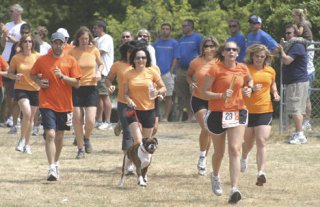LANGLEY — It took them 28 hours, 45 minutes and 9 seconds and they placed 108 out of 142 teams, but it was worth it.
“Our team of 11 chicks and one dude — team captain Mynda Myres plus Brenda Dawson, Heather Dubendorf, Suzy Windes, Nisa Heggenes, Challis Stringer, Kelly Henriot, Cynthia Allen, Christina Bromme, Annabet Berlin, Rebecca Valdivia and Brian Vick — beat last year’s time by 45 minutes,” said Dawson.
This was the Ragnar Relay’s second year, and its popularity has grown, from 744 runners to 1,704.
The race began Friday morning in Blaine and wended its way 187 miles south to end at Langley Middle School.
The race is part of a relay series called Northwest Passage for novice and intermediate runners. Each team member runs three legs, ranging between seven and 18 miles, supported by two vehicles.
Driving the vans and providing moral support were Tasha Blasko and Maria Reyes
Volunteers included Richard and Kay Stanley, Diane Fraser and Patti Sargent.
When the final runner approached, the whole team gathered and ran across the finish line together to the raucous cheers of friends and families before heading to the beer garden at the county fairgrounds in Langley.
Named after a ninth-century Norse king, the Ragnar Relay group sponsors similar relays in Arizona, Wisconsin, Utah, Florida, Texas and Washington, D.C.
“When we pick a new course, our criteria includes a beautiful route, cooperative local officials and an active running community,” said senior race director Dominique Meier. “South Whidbey certainly qualifies on all counts.”
Meier said that each year the event typically doubles in size, and they expect the same will happen with the Northwest Passage.
“People like running with their friends, and the word spreads,” he said. “It turns into an overnight slumber party with a competitive edge.”
The relay takes 24 hours to complete, so each team member ran one leg under the Washington moonlight while equipped with a flashlight and reflective vest.
The first leg got off to a successful start at 9 a.m. Friday in Blaine, with Dawson the first runner.
“After a slight mishap regarding a dropped baton, Nisa made her way to Birch Bay,” Dawson said. “Suzy had a hot 8.3 miles, then handed off to Heather who had a nice, cooler evening run. Mynda took off on her first leg and quickly remembered why she didn’t like that leg last year.”
Myres said the big difference was that she knew what to expect, such as a big hill, but she was undaunted by the challenge.
Stringer had a bit of excitement on her run into Bellingham when she had to alert a local police officer of a brush fire.
“I ran past a cedar planter that was in flames,” Stringer recalled. “I waved at some people who apparently thought I was nuts and ignored me, so I flagged down a motorcycle cop and he took action.”
The balance of the race went off without a hitch.
At the finish, Henriot noted that this race was more fun than most.
“We’re together all that time, and I learn cool stuff that I can’t talk to you about,” she laughed.
Like the others, Dubendorf ran three legs of five to seven miles.
“Brenda talked me into this at a vulnerable moment,” she said. “But it was worth it, though
I could sure use some sleep.”
Race organizers had a lot of help, especially from the 60-strong members of the Island County Amateur Radio Club who served as eyes and ears along the route.
“We do this as a public service,” spokesman Alan Whitman of Langley said. “But it is great practice for our ham-radio operators who use the exercise to prepare for a future emergency.”
Runners pay about $80 each to participate, with part of the proceeds going to the charity Room to Read, which provides scholarships for children in developing nations.
The concept was begun in 2004 by Steve Hill.
“I used to run the Hood to Coast race in Oregon and thought this would be a fun excuse to get friends together,” he said.
The first race from Logan to Salt Lake City in Utah drew 22 teams.
“This year, about 7,000 ran that course,” Hill noted.
“This one has more twists and turns than most of our races, but the level of enthusiasm and local help is huge.
“And we’ll be back next year; Langley is a great place with great people,” Hill said.



